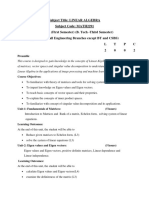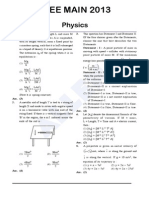19EMA 101SyllabusMathematics ICommontoallexceptBiotech
19EMA 101SyllabusMathematics ICommontoallexceptBiotech
Uploaded by
razesCopyright:
Available Formats
19EMA 101SyllabusMathematics ICommontoallexceptBiotech
19EMA 101SyllabusMathematics ICommontoallexceptBiotech
Uploaded by
razesOriginal Title
Copyright
Available Formats
Share this document
Did you find this document useful?
Is this content inappropriate?
Copyright:
Available Formats
19EMA 101SyllabusMathematics ICommontoallexceptBiotech
19EMA 101SyllabusMathematics ICommontoallexceptBiotech
Uploaded by
razesCopyright:
Available Formats
19EMA101: ENGINEERING MATHEMATICS-I Syllabus
CALCULUS & ALGEBRA
(Common to all branches of Engineering except Biotechnology)
L T P C
3 0 0 3
This course is designed for the students of all B.Tech programmes except for Bio-Technology as
a prerequisite for the core programmes.The course imparts knowledge on Matrix Algebra and
basic concepts of Calculus as these concepts lay a strong foundation in applications in
Engineering.
Course Objectives:
To familiarize the students with the theory of matrices and quadratic forms.
To explain the series expansions using mean value theorems.
To teach basic concepts of partial derivatives.
To explain the evaluation of double integrals and its applications.
To demonstrate the evaluation and applications of triple integrals.
Bridge Course: Limits, Continuity, Types of Matrices
Unit I: Matrices 10 hrs
Rank of a matrix by echelon form, solving system of homogeneous and non-homogeneous
linear equations. Eigen values, Eigen vectors and their properties, Cayley-Hamilton theorem
(without proof), finding inverse and power of a matrix by Cayley-Hamilton theorem,
diagonalisation of a matrix, quadratic forms and nature of the quadratic forms, reduction of
quadratic form to canonical forms by orthogonal transformation.
Learning Outcomes:
At the end of this unit, the student will be able to
solve systems of homogeneous and non-homogeneous linear equations (L3)
calculate the eigenvalues and eigenvectors of a matrix (L3)
identify special properties of a matrix (L3)
Unit II: Mean Value Theorems 6 hrs
Rolle’s Theorem, Lagrange’s mean value theorem, Cauchy’s mean value theorem, Taylor’s and
Maclaurin’s theorems with remainders (without proof).
Learning Outcomes:
At the end of this unit, the student will be able to
demonstrate the given function as series of Taylor’s and Maclaurin’s with remainders
(L3)
illustrate series expansions of functions using mean value theorems (L3)
Unit III: Multivariable Calculus 8 hrs
Partial derivatives, total derivatives, chain rule, change of variables, Jacobian, maxima and
minima of functions of two variables, method of Lagrange multipliers.
Learning Outcomes:
At the end of this unit, the student will be able to
interpret partial derivatives as a function of several variables (L3)
evaluate maxima and minima of functions (L3)
apply Jacobian concept to deal with the problems in change of variables (L3)
Unit IV: Multiple Integrals-I 8hrs
Double integrals, change of order of integration, double integration in polar coordinates, areas
enclosed by plane curves.
Learning Outcomes:
At the end of this unit, the student will be able to
apply double integrals of functions of several variables in two dimensions in
cartesian and polar coordinates (L4)
calculate the areas bounded by a region using double integration techniques (L3)
Unit V: Multiple Integrals-II 8 hrs
Evaluation of triple integrals, change of variables between Cartesian, cylindrical and spherical
polar co-ordinates, volume as triple integral.
Learning Outcomes:
At the end of this unit, the student will be able to
apply multiple integrals in Cartesian, cylindrical and spherical geometries (L4)
evaluate volumes using triple integrals (L4)
Text Books:
1. Erwin Kreyszig, Advanced Engineering Mathematics, 10/e, John Wiley & Sons, 2018.
2. B. S. Grewal, Higher Engineering Mathematics, 44/e, Khanna Publishers, 2017.
References:
1. R. K. Jain and S. R. K. Iyengar, Advanced Engineering Mathematics, 3/e, Alpha Science
International Ltd., 2002.
2. George B. Thomas, Maurice D. Weir and Joel Hass, Thomas Calculus, 13/e, Pearson
Publishers, 2013.
3. Glyn James, Advanced Modern Engineering Mathematics, 4/e, Pearson publishers, 2011.
Course Outcomes:
At the end of the course, the student will be able to
utilize the techniques of matrix algebra that is needed by engineers for practical
applications (L3)
apply mean value theorems to engineering problems (L3)
utilize functions of several variables in optimization (L3)
employ the tools of calculus for calculating the areas (L3)
calculate volumes using multiple integrals (L3)
You might also like
- BookDocument238 pagesBookRajesh RajNo ratings yet
- Lesson Plan: Lesson: Uses of Mass SpectrometryDocument4 pagesLesson Plan: Lesson: Uses of Mass SpectrometryMarcTnn100% (1)
- Red Lion Path-DryDocument2 pagesRed Lion Path-Drytravellerfellow50% (2)
- Syllabus For 3rd Semester AE (All Subjects)Document17 pagesSyllabus For 3rd Semester AE (All Subjects)Deepak PoudelNo ratings yet
- Mathematics SyllabusDocument13 pagesMathematics SyllabusSARTHAK SHARMANo ratings yet
- Maths1year CommonDocument6 pagesMaths1year CommonKrishna yadavNo ratings yet
- Mathematics 1 Autonomous SylDocument1 pageMathematics 1 Autonomous Sylravi167784No ratings yet
- Ma3151matrices and Calculusl TPCDocument3 pagesMa3151matrices and Calculusl TPCvanithasenthilemailNo ratings yet
- Problems Using ScilabDocument28 pagesProblems Using Scilabdeepika snehiNo ratings yet
- Syllabii S&H2019 20 PDFDocument22 pagesSyllabii S&H2019 20 PDFEshan ParekhNo ratings yet
- Materias FIECDocument22 pagesMaterias FIECwildpereNo ratings yet
- Sem-3 Complete Syllabus-1Document20 pagesSem-3 Complete Syllabus-1meenamonika048No ratings yet
- Department of Physics Bsc. (Hons.) Physics: Discipline Specific Core Course - 1 (Dsc-1) Mathematical Physics IDocument96 pagesDepartment of Physics Bsc. (Hons.) Physics: Discipline Specific Core Course - 1 (Dsc-1) Mathematical Physics IHimanshu JoshiNo ratings yet
- Sem I Syllabus BSC (Hons. Physics)Document13 pagesSem I Syllabus BSC (Hons. Physics)Rizwan ChoudharyNo ratings yet
- MATH2291-Linear Algebra-SyllabusDocument3 pagesMATH2291-Linear Algebra-SyllabusAbhishek KumarNo ratings yet
- Mathematics - Syllabus - B.Tech - First Year - 2022-23Document8 pagesMathematics - Syllabus - B.Tech - First Year - 2022-23iamvishu000No ratings yet
- Computational Methods in Aerospace Engineering SylabusDocument2 pagesComputational Methods in Aerospace Engineering Sylabussreenadh chevulaNo ratings yet
- Tma-101 Engineering Mathematics-I: LTPC 3 1 0 4Document2 pagesTma-101 Engineering Mathematics-I: LTPC 3 1 0 4mm8871No ratings yet
- AppendixA-BTech-CSE-AI and ML 2021-25Document74 pagesAppendixA-BTech-CSE-AI and ML 2021-25jinsonriniNo ratings yet
- 22BM1103Document2 pages22BM1103singhashwin843No ratings yet
- MA5158 ENGINEERING MATHEMATICS SyllabusDocument2 pagesMA5158 ENGINEERING MATHEMATICS SyllabusMitz best100% (1)
- ECE II Sem SyllabusDocument8 pagesECE II Sem Syllabusrajsandeep2410No ratings yet
- Mathematics 2 PDFDocument4 pagesMathematics 2 PDFAbsolute ZeroNo ratings yet
- BMATS201Document5 pagesBMATS201Nithin GowdruNo ratings yet
- I B Tech s-13 SyllabusDocument40 pagesI B Tech s-13 Syllabusapi-279049687No ratings yet
- 2nd SemesterDocument29 pages2nd SemesterARGHA ChakrabortyNo ratings yet
- Electroncis and Communication Engineering - 2019 PDFDocument51 pagesElectroncis and Communication Engineering - 2019 PDFPandu NarendraNo ratings yet
- Math F112 1011 20240110222328Document4 pagesMath F112 1011 20240110222328refernubileNo ratings yet
- Algebra Lineal UNIDocument3 pagesAlgebra Lineal UNIEduardo RNo ratings yet
- BMATE101Document5 pagesBMATE101ManjunathNo ratings yet
- 24MA101Document2 pages24MA10123102208No ratings yet
- BMATC101Document5 pagesBMATC101Ravikiran SharmaNo ratings yet
- MathDocument1 pageMathjatinNo ratings yet
- Mth213:Complex Algebra: Page:1/1 Print Date: 6/23/2016 2:48:24 PMDocument1 pageMth213:Complex Algebra: Page:1/1 Print Date: 6/23/2016 2:48:24 PMvenkatNo ratings yet
- BMATS101Document5 pagesBMATS101Shankha Suvro DuttaNo ratings yet
- Bas 103Document2 pagesBas 103guptaanant01kNo ratings yet
- Birla Institute of Technology and Science, Pilani Pilani Campus AUGS/ AGSR DivisionDocument4 pagesBirla Institute of Technology and Science, Pilani Pilani Campus AUGS/ AGSR DivisionPriyam VermaNo ratings yet
- Calculus and Linear Algebra UG - First Semester (Common To All Branches)Document3 pagesCalculus and Linear Algebra UG - First Semester (Common To All Branches)60 - R - OP ChoudharyNo ratings yet
- Mat 3 SyllabusDocument2 pagesMat 3 SyllabusAshutosh KaushikNo ratings yet
- National University of Engineering Naval Engineering ProgramDocument3 pagesNational University of Engineering Naval Engineering ProgramAndreiNo ratings yet
- 177 BTechMathematicsR22SyllabusDocument21 pages177 BTechMathematicsR22SyllabusAshish Ranjan SinghNo ratings yet
- m3 Sem3 SylabusDocument1 pagem3 Sem3 Sylabussandeep67890000No ratings yet
- Math c192 IdDocument3 pagesMath c192 IdAvinash ReddyNo ratings yet
- Mathematics DefintionsDocument8 pagesMathematics DefintionsSikandar KhanNo ratings yet
- 22MATC11Document5 pages22MATC11Akash GVNo ratings yet
- 01ma1101 Differential and Integral CalculusDocument3 pages01ma1101 Differential and Integral CalculusTYTEC TUBE100% (1)
- 20EC1115Document2 pages20EC1115Aditi KarvekarNo ratings yet
- Calculus and Analytical GeometryDocument1 pageCalculus and Analytical GeometryJohn KasiNo ratings yet
- Bmat201 PDFDocument5 pagesBmat201 PDFThaanya sNo ratings yet
- CourseMarial 359d7MAT101Document2 pagesCourseMarial 359d7MAT101Aryan KushwahNo ratings yet
- 19MT1201 Mathematics For Engineers PDFDocument2 pages19MT1201 Mathematics For Engineers PDFChaitanya CheyNo ratings yet
- RGPV Syllabus Aicte BT 102 Mathematics 1Document1 pageRGPV Syllabus Aicte BT 102 Mathematics 1Aryan RaiNo ratings yet
- RGPV Syllabus Aicte BT 102 Mathematics 1Document1 pageRGPV Syllabus Aicte BT 102 Mathematics 1Daniel DanishNo ratings yet
- Visvesvaraya Technological University, BelgaumDocument26 pagesVisvesvaraya Technological University, BelgaumVinay DesaiNo ratings yet
- ETC-EC-EN 2 YR CurriculumDocument50 pagesETC-EC-EN 2 YR CurriculumAmit TripathiNo ratings yet
- Course Code: MA102 Title: Engineering Mathematics - IDocument4 pagesCourse Code: MA102 Title: Engineering Mathematics - Ishivang ranjanNo ratings yet
- Course Title: Basics Mathematics (Code: 3300001)Document34 pagesCourse Title: Basics Mathematics (Code: 3300001)MANSINo ratings yet
- MA8151 Engineering Mathematics SyllabusDocument2 pagesMA8151 Engineering Mathematics SyllabusPAMANI1981No ratings yet
- B.tech r20 Cse Ai ML SyllabusDocument166 pagesB.tech r20 Cse Ai ML SyllabusBarani AbhishekNo ratings yet
- RGPV Syllabus Btech 1 Sem bsc103 Mathematics 1Document1 pageRGPV Syllabus Btech 1 Sem bsc103 Mathematics 1Babin BidNo ratings yet
- Complex Variables for Scientists and Engineers: Second EditionFrom EverandComplex Variables for Scientists and Engineers: Second EditionRating: 5 out of 5 stars5/5 (1)
- A Geometric Algebra Invitation to Space-Time Physics, Robotics and Molecular GeometryFrom EverandA Geometric Algebra Invitation to Space-Time Physics, Robotics and Molecular GeometryNo ratings yet
- 17 WEP SpringsDocument8 pages17 WEP SpringseltytanNo ratings yet
- HEC 7 8 1HC0070730AB en HighDocument5 pagesHEC 7 8 1HC0070730AB en HighHoangNo ratings yet
- 03 Reference Material HMT ME302 Steady Heat Conduction PDFDocument38 pages03 Reference Material HMT ME302 Steady Heat Conduction PDFhimanshu singhNo ratings yet
- Test - 1 Answer Key: Neet Booster Test Series (NBTS) For Neet-2021Document25 pagesTest - 1 Answer Key: Neet Booster Test Series (NBTS) For Neet-2021Omprakash BhojaneNo ratings yet
- Immediate Download Etextbook 978-0077687342 Vector Mechanics For Engineers: Dynamics 11th Edition Ebooks 2024Document49 pagesImmediate Download Etextbook 978-0077687342 Vector Mechanics For Engineers: Dynamics 11th Edition Ebooks 2024mimranancee100% (3)
- Quantum Computation in Brain Microtubules? Decoherence and Biological FeasibilityDocument10 pagesQuantum Computation in Brain Microtubules? Decoherence and Biological Feasibilityl4dy3v1lNo ratings yet
- Ion Exchange Column DesignDocument20 pagesIon Exchange Column Designsemihoksay100% (1)
- JEEMAIN 2013 Question PaperDocument11 pagesJEEMAIN 2013 Question Papersanchit199617100% (1)
- RT R1 Exam Questions: D. The Total Number of Particles in The Nuclear of Ir-192Document7 pagesRT R1 Exam Questions: D. The Total Number of Particles in The Nuclear of Ir-192Anbarasan Perumal100% (2)
- Damage StabilityDocument11 pagesDamage Stabilitypolaris25100% (2)
- Glass Design MeplaDocument5 pagesGlass Design MeplaLaurence SarmientoNo ratings yet
- MetalografiDocument40 pagesMetalografisunaryoNo ratings yet
- Topic 2-1f37518Document31 pagesTopic 2-1f37518norzamiraNo ratings yet
- Hydrothermal Synthesis and Microstructural, Optical Properties Characterization of YVO Phosphor PowderDocument6 pagesHydrothermal Synthesis and Microstructural, Optical Properties Characterization of YVO Phosphor Powdermraouefel ahlameNo ratings yet
- PBT GF30 enDocument1 pagePBT GF30 enSteven Rojas JerezNo ratings yet
- MODULE 2 - What's MoreDocument5 pagesMODULE 2 - What's MoreMaria Rodelyn100% (1)
- E-Book, Statics, Mechanics Revision Notes From A-Level Maths TutorDocument21 pagesE-Book, Statics, Mechanics Revision Notes From A-Level Maths TutorA-level Maths TutorNo ratings yet
- Manual de Lecho MixtoDocument120 pagesManual de Lecho MixtoIQLEPENo ratings yet
- Periodic Classification of ElementsDocument20 pagesPeriodic Classification of Elementsthinkiit100% (3)
- Inelastic Seismic Performance of RC Tall Piers With Hollow SectionDocument8 pagesInelastic Seismic Performance of RC Tall Piers With Hollow SectionMadhurimaMitraNo ratings yet
- CyclopentadieneDocument27 pagesCyclopentadieneNilmani SinghNo ratings yet
- Science ExperimentsDocument53 pagesScience ExperimentsankucakNo ratings yet
- November 2021 (v1) QPDocument28 pagesNovember 2021 (v1) QParhamrafique42No ratings yet
- Sinir Tabaka Teorisi: Y.Doç - Dr. Onur Tunçer İstanbul Teknik ÜniversitesiDocument22 pagesSinir Tabaka Teorisi: Y.Doç - Dr. Onur Tunçer İstanbul Teknik ÜniversitesiHasan Kayhan KayadelenNo ratings yet
- Perhitungan Rotary DryersDocument5 pagesPerhitungan Rotary DryersAgung Siswahyu100% (1)
- Chap4-Insulation Coordination LatestDocument41 pagesChap4-Insulation Coordination LatestAhmed TayehNo ratings yet
- Unit 7 ExercisesDocument2 pagesUnit 7 Exercises张书No ratings yet
- Sigworth MatrixDocument10 pagesSigworth MatrixJeannette CraigNo ratings yet

























































































